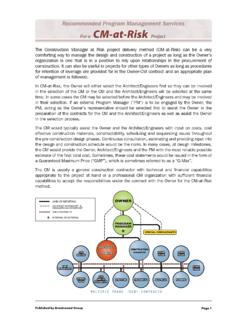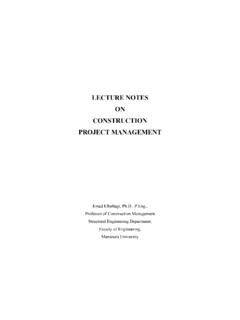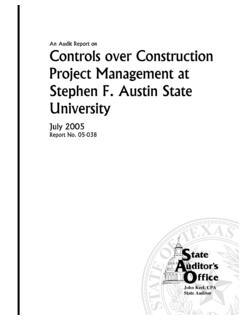Transcription of A History of Construction Management Program …
1 A History of Construction Management Program Management and Development Management An industry and Personal History by George T. Heery FAIA RIBA FCMAA November 2011 During World War II there was virtually no Construction taking place in America except for Construction related to the war effort. In the years immediately after the war, on into the early 1950s, most Construction in America was for catch up projects such as additions to the local school or hospital, new private houses, repair and expansion of the wet and dry civil infrastructure, repair and expansion of all sorts of other facilities and a good many relatively small to modest sized commercial, industrial and governmental projects. However, by the mid 1950s much larger Construction programs were being planned and built throughout America. These included many huge new hospitals, large school building programs, other major public projects such as tunnels, bridges and expressways, larger more modern industrial, business, public and military facilities, and other large projects of all sorts.
2 By the 1960s there were many larger projects being put out for Construction bids and under Construction . Also, the 60s saw very high rates of inflation in the economy ---- the highest seen in America up until then except during war time ---- and the cost of money began to soar in the credit markets. Further, up until that time, there was no separate profession dedicated to the overall Management of these huge projects on behalf of the owner. As a result it was common for these large projects, mostly for public owners, private non-profit institutions and major corporations, to run into both delays in Construction and unpredicted high bids as well as significant cost increases to the owner during Construction . Also, as a further result, during the 60 s there was the search for the guilty as a major topic of discussion and concern among governmental and corporate project owners, architects and engineers. Since the bearers of the bad news, in the form of unexpectedly high bids or unexpected and large contractor initiated change orders, were the general contractors, many saw the general contractor as the guilty party.
3 Partially as a result, the idea began to be floated of a professional Construction manager, envisioned then as an entity which would replace the general contractor and be fee compensated, though in some cases with time and cost control incentives. The idea was that the professional Construction manager would buy out the project competitively from trade ( sub ) contractors and building product manufacturers. These contracts would be between the owner and the respective trade contractor or supplier with the Construction manager designated in those contracts as the owner s representative. If there needed to be early awards of certain of the trade contracts or long lead procurements before the final design was completed, they would be awarded in a similar fashion. Meanwhile, in the architectural practice of Heery & Heery, as we began to grow, we encountered resistance to our modern design philosophy. In the Southeastern both business and institutional leaders were slower than their counterparts in other parts of the country to abandon traditional architectural design and embrace the modern movement.
4 However, I was fresh out of Georgia Tech s architectural Program and was a dedicated disciple of the Bauhaus. In our part of the country, the exception to clients who wanted to stay with traditional architectural design were the executives of manufacturing companies when it came to the design of their manufacturing and assembly plants as well as distribution centers. At the same time, the South was then attracting a lot of the expansion and relocation of industry from the Northeast and upper Midwest. So we began, with some success, to focus on that design services market. Soon, though, we found our competitors were not so much other architects as they were the design-build contractors who claimed faster delivery and lower costs to the owner. So we set out to compete with that approach delivering faster designed and built facilities at lower costs without giving up our professional designer and adviser status (much less our Bauhaus ideals).
5 Soon we realized we were delivering not only architectural and engineering services but also Construction Management services. In turn, we built a pretty good regional reputation as good architects who could get the client s building completed quickly and within smaller budgets. We began to call what we did Architectural, Engineering and CM services. This approach of combining architectural, engineering and Construction Management services stood us in good stead when we were appointed along with the firm of Finch, Alexander, Barnes, Rothschild and Paschal to design and manage the Construction of the new Atlanta and Fulton County Stadium which had to be designed in secret and built within one year as part of the Braves Baseball team s move from Milwaukee to Atlanta. No one had built a major league stadium since World War II in much under two years. Yet, at age 36, serving as the Project Manager for what came to be called Heery-Fabrap, I told the mayor of Atlanta, the Chairman of the largest bank in Atlanta and the head of the Atlanta Coca-Cola Bottling company, Arthur Montgomery, who was asked by the Mayor to serve as Chairman of the Atlanta and Fulton Country Recreation Authority, that we could do that.
6 And we did, in fact, complete the Construction and open for the Braves to play their first game in Atlanta 11 months and 3 weeks after we broke ground, and the cost of only $13 Million was within the original budget and schedule. Shortly afterwards, Heery & Heery was engaged by Lockheed to help plan new facility needs for Lockheed obtaining the contract from the Air Force to design and manufacture of the huge C5A military transport at their Marietta, Georgia plant. The first and long-lead project was to be a 300,000 square foot new one story office building to provide the space for the aircraft s design engineers. To meet the aircraft design and manufacturing schedule the new facility had to be completed within 100 calendar days after Lockheed was awarded the contract and neither final design nor Construction could start until Lockheed had the contract for the airplane. To achieve that we developed a preliminary plan to use a modular pre-engineered industrialized building system referred to as the SCSD system.
7 This was a pre-engineered, pre-fabricated system made up of a 5 foot grid light structural steel frame coordinated with pre-engineered ceiling, HVAC distribution and lighting systems and other components. SCSD stood for School Construction Systems Development, the brain child of architect Ezra Ehrenkrantz and was developed under a grant from the Ford Foundation through its Educational Facilities Laboratory in New York City headed by a former educator, Dr. Harold Gores. As our Lockheed project moved along, I got a call from Dr. Gores saying that he and Mr. Ehrenkrantz wanted to come see me, which they did. I thought they were coming to see us to say how happy they were that we were making other uses of their system. Instead, they came to say that we had bought up all of their system components that they were planning to use on some school projects. They wanted me to look for other alternatives for our Lockheed project.
8 That was not feasible and it would have been unethical in terms of our obligations to our client. Our procurement procedures on behalf of Lockheed were very strong, and we could not help the Educational Facilities Laboratory with their problem. So the Lockheed project continued on schedule using the SCSD system and was completed on time. However, shortly afterwards, Dr. Gores called me to ask if we could act as Construction Management consultants to the Minnesota State College system on 11 projects they needed to undertake on an accelerated basis. The Educational Facilities Laboratory was willing to foot the bill for our services. Of course we said yes and we did help them make a success of their accelerated projects. That was the first time (1968) that Heery & Heery provided Construction Program Management services for projects for which we were not also the architect. It was in that period of the mid 1960s that a small company, AMR, which I think stood for Advanced Management Research, and which put on various types of seminars around the country on such subjects as tax shelters, better personnel Management procedures, and the like, heard the term Construction Management .
9 The AMR guys found that there was widespread interest in this not-yet-fully-defined area of business and decided to put on seminars on the subject of Construction Management . For a seminar faculty AMR recruited Chuck Thomsen, then head of Construction Management for CRS and later to become the Chairman/CEO of 3DI, Bob Marshall of Turner Construction Company, Jim O Brien, the author of the book on the then relatively new, computer based Critical Path Method, Al Dell Asola, the father of value engineering, Frank Mueller, a Construction consultant, Wally Meisen and Bert Berrebe of GSA and several others including myself. This went on for several years. Also, Louis N. Vic Maloof, my close friend and colleague at Heery & Heery, took my place as a faculty member on several occasions. These were all knowledgeable people from the Construction industry , related consulting firms or from the Public Building Service of GSA. I think it is fair to say that we all brought something to the table.
10 AMR would put on one of these seminars every 6-10 weeks, each time in a different city. The sessions lasted a couple of days. Each of us made a presentation for the paying audience on some aspect of the subject. The faculty usually gathered at the seminar hotel the evening before and swapped ideas and experiences. It was a very interesting time and set of events as well as a learning experience for all of the faculty as well as the seminar attendees. In our evening sessions preceding the AMR seminars, with the term Construction Management referring to the concept of replacing the traditional general contractor with a professional Construction manager, the faculty members traded ideas about how to improve on the approaches and services of this relatively new profession. However, I began to make the case with my colleagues in AMR s CM Faculty that if you are going to successfully deal with the issues of time and cost control that you had to deal with more than the Construction process and the builders.








